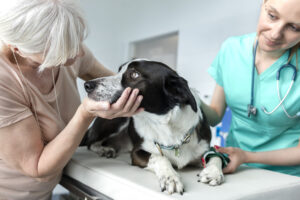The best day for a pet parent is the day a new puppy or kitten arrives. Every day after that is the next best day. My toy poodle, Rugby came to my family at six months of age. He was meant to be a gift to his original owner’s parents but something happened and they needed to find another home for him. While scrolling online, my husband saw his photo. When he showed it to me, I fell instantly in love. My husband and daughter drove to a suburb just outside of Atlanta, Georgia to get him the very next day. He arrived at his new home scruffy, adorable and eager. In no time at all, we were family. That was almost eight years ago.
I am painfully aware of how quickly the years are passing. Generally, dogs are considered a senior pet at age seven. While smaller breeds tend to have a longer life span, I fully understand there are no guarantees in life. Though I hope Rugby will be with us for many, many years to come, I know there are concrete steps I can take to keep him healthy, happy and aging gracefully.
Some signs of aging in pets include white beards and eyebrows, less agility, more stiffness, waning eyesight, fatty lumps, benign lipomas, and increased anxiety and grumpiness. Similar to humans, an aging pet will experience glorious bursts of energy. Playing with a favorite toy, hearing his leash being readied for an outside walk, or an invigorating bath inspire Rugby’s energy level to heighten. A tear through the house often follows one of his favorite activities reminding me of the energetic puppy he once was.
Though Rugby is getting older, his favorite things remain the same. Snuggles under the covers, puppy kisses, naps on the lap of any family member who happens to be sitting down, car rides, treats and curling up in a spot of sunshine on the dining room floor continue to make him wildly happy. Still I find myself wondering is there more I could be doing to keep him healthy and happy?
There are many ways to manage an aging pet’s physical ailments. Thundershirts can help with anxiety. Steps leading up to the bed can make it more easily accessible for pets with painful joints. Exercise is always good. Routine checkups with your pet’s veterinarian are vitally important.
Common medical problems for aging pets include arthritis, kidney disease, dental disease, dementia, heart disease, diabetes, urinary incontinence and cancer. While some of these ailments are easy to notice, others require the eye of a trustworthy veterinarian trained in the art of noticing the subtle signs of disease and aging. Our pets cannot tell us what aches or hurts. Sometimes we notice something only after it could be a significant issue and harder to medically treat. Senior pets should see their veterinarian twice a year. In order to make the most of these visits, keep notes on your pet. Any changes in her eating or drinking habits, bodily functions, sleep patterns, energy levels, or mental sharpness? Have you noticed any lumps? Share this information with your veterinarian to give them a complete picture of your pet’s health.
Physical ailments are easier to treat than mental ones. Senility in pets is similar to Alzheimer’s in humans. Pets will experience good days and bad days. Signs your pet may be senile include constant pacing, vocalizing more, failure to recognize you, and eating things off limits. Treatment options are available including medications and special diets.
Other options for a pet experiencing senility are puzzle games and toys. Much the same as humans facing an Alzheimer’s diagnosis, exercises to keep the brain active and engaged are important. Filling hollow rubber toys with peanut butter or treats will engage your pet’s mind. They also have the added benefit of providing more aerobic exercise for senior pets without endurance.
Nonsteroidal anti-inflammatory drugs and nutraceuticals, such as Dasuquin, can be quite helpful in treating joint pain in senior pets. Sam Meisler, veterinarian and owner of My Pet’s Animal Hospital, encourages pet parents not to overlook the possibility of painful joints in senior pets. “Don’t assume that your pet is not in pain just because she is not complaining. At least get her on a nutraceutical if she is over seven years of age,” Dr. Meisler says.
Water therapy is an alternative treatment for pets struggling with arthritis. Anything that can help strengthen an older pet’s body will provide a positive impact on their quality of life. Most older pets are dealing with some arthritis. A good, regular exercise program can slow down its progression.
A longer life doesn’t always mean a better one. Paying attention to our pets as they age is important. We don’t want them to suffer or live with debilitating pain simply because we can’t bear to part with them. Sometimes the greatest gift we can give a beloved pet is the hardest for us. That last loving decision you make for your pet is often one of the most painful but also vitally important. They are relying on us to make it. While we all hope our pets will have a natural death and gently drift off to sleep for good, this often is not the case. The thought of euthanasia is one no one wants to face but it is necessary.
Our pets give us so much. Not only do they provide unconditional love, they are a source of true joy. Doing all you can to give your pet a happy and healthy lifestyle is important for their well being as well as yours. And the best advice to parents of an aging pet? Love them with your whole heart and appreciate every day they are in it.



